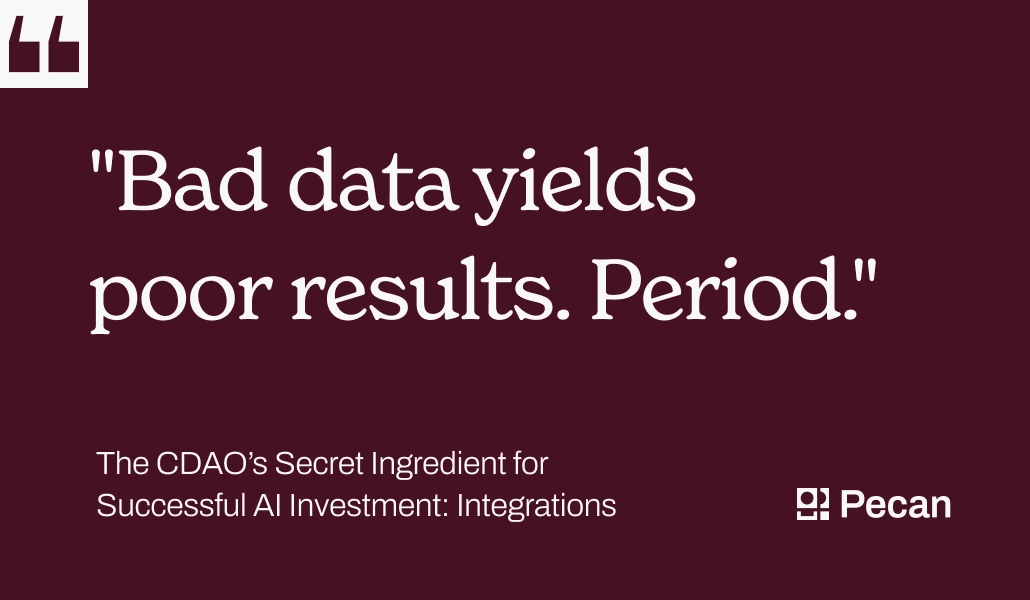With 83% of companies considering AI a top priority for improving their business strategy, it’s almost certain that talks of implementing AI into your data and analytics department have been dominating your team’s plans for 2024 and beyond.
However, with so many products on the market, choosing which AI platforms and technologies will best serve your data and analytics team is difficult, to say the least. For instance, in early 2023, nearly $50 billion was raised for generative AI and AI-related companies entering the market — and there’s no doubt that number will continue to rise as brands hop on the AI train.
As a chief data officer, how do you make an intelligent investment in AI?
This question is important to consider, as making the wrong choice could have repercussions that last for years. According to Gartner, the “rapid evolution of D&A and AI technologies (such as GenAI) offers leaders the opportunity to rethink and evolve their operating models.” However, with this opportunity comes change — and sometimes, that change is forced, becoming a roadblock. Gartner adds, “Sixty-six percent of [organizations] have had to reconsider their [data & analytics] operating model due to disruptive technology.”
Ideally, you'd want an AI solution that offers immediate value while setting up your team and infrastructure for ongoing success (think improved ROI with minimal technical debt).
In this article, we highlight the most essential variable you should consider when searching for an AI tool for your data and analytics team: integrations.
How do a solution’s integration capabilities determine the success of AI initiatives?
You can think of integrations from two angles: The first is how new technology integrates with your existing analytics infrastructure (think cloud data warehouses and data lakes; other critical databases, like a CRM system or a sales database; and your existing analytics technology, such as an automated dashboarding tool).
The second angle is how well your AI solution integrates with your daily workflow, including your employees' existing technology and their individual skill levels. In other words, will they be able to use this new technology, will it enhance their effort, and will it help them create more value? The solutions that foster these two elements of integration will set you up for lasting success.
Here are some of the benefits you can expect from an AI platform that fits these integration criteria — and some of the consequences if your platform doesn’t.
Deeper insights
The first law of thermodynamics states that matter can neither be created nor destroyed. Conversely, the first (unofficial) law of data analytics is that inputs determine outputs. Bad data yields poor results. Period. Whereas high-quality data provides trustworthy insights that stakeholders can use to make confident decisions.
Regardless of whether you’re seeking a generative AI tool or a predictive AI tool, when your tool integrates with your data sources seamlessly, you’ll see a much better output. For example, if you’re building a predictive model, the predictive AI tool will need to pull from historical data to construct the model.
When your team has easy access to the full breadth of your data through built-in integrations, it can make rich and more accurate conclusions, increasing:
- The accuracy of your models
- The breadth of the model
- The specificity of the model’s output
Now, this isn’t foolproof because the quality of your data is important. If your AI tool has full access to your data but you don’t have quality data to examine, you may still come up with some surface-level conclusions.
Streamline collaboration across departments
Most organizations with under 500 employees use over 150 tools to keep their company running smoothly, and the number is even higher for larger enterprises. Keeping track of where data is coming from across departments is difficult.
Different departments use different tools. Your marketing, finance, legal, and data teams may have completely different departmental tech stacks, and their data may reside within unique applications. So when you need to work with other departments, integrating with their technology and data stack is a must.
While we recommend an AI tool with a breadth of integration capabilities so overcome this obstacle, there are two alternatives if you can’t integrate with every application:
1. Purchasing an additional tool to adapt your data to fit your AI tool.
When AI tools require specifically formatted data, you may need to bring another piece of software on board to translate your data into the format the tool requires. However, this process is also likely to be very manual and time-consuming.
2. A person or team within your organization is tasked with performing what an integrative tool could do automatically.
This is the most likely solution to an AI tool with poor integrative capabilities, and it’s a recipe for technical bottlenecks. When your AI tool isn’t integrated with your data warehouse, departments must rely on one another to use the tool. For example, your analytics team will have to contact your marketing department to receive CSVs or Excel files, and so on.
You can cut out unnecessary steps by ensuring your tool can sync with other departments’ data sources out of the box.
Compliance and governance
According to Gartner, organizations with mature data and analytics governance practices are 47% more likely to adopt innovations. As a CDO or CDAO, there’s no doubt that compliance and governance are top of mind.
An important part of data compliance is tracking the movement and usage of your data. When your AI tool offers integration with your data, it’s simple to see where the data has come from and how it’s been transformed.
But in situations where you have to input data manually or without an automatic integration, it’s far more difficult to track data’s movement. This can cause major governance issues. To combat the lack of integration of your AI tool, you would need to bring another software onto your tech stack to track your data’s movement or dedicate someone on your team solely to documentation and governance.
Overall, it’s a recipe for confusion and noncompliance — especially when you’re utilizing PII.
Tracking data movements is exceptionally simple and straightforward when your data storage integrates with your AI solution. It shrinks technical debt and streamlines your processes so you can sleep easy at night, knowing your model is totally compliant.
Adaptability to organizational change
Businesses pivot. New technology is created. Making room for organizational evolution is an important part of being an effective leader. To create a tech stack that can manage change, you’ll want to ensure a breadth of available integrations from your tools.
“In 2026, 75% of CDAOs that have failed to make organization-wide influence their top priority will have been assimilated back into technology functions.”
— "The Gartner Predictions for 2024: Data & Analytics,” Gartner
Tools with limited integrations or with only one accepted data format aren’t adaptable to system change. If your organization switches data storage tools, you’ll need to get a different AI tool.
But if your AI tool has a wide number of accepted formats and data warehouse integrations, it’s more likely to stand the test of time within your company. This is essential for building a future-ready infrastructure.
Another important way integrations increase organizational adaptability is if your organization’s makeup changes. If departments reorganize, or an integral team member leaves your organization, your AI tool’s productivity shouldn’t be dependent on one person or team to feed data into the system. Integrations make much of the work happen automatically, so shifting hands is easy.
Scalability
When your AI doesn’t integrate directly with your data storage tool, it means that funneling additional data from your growing customer base is manual. If a person on the data team has to send CSV files over email, their job will now take quite a bit longer.
But when your AI tool automatically connects, the amount of data you have doesn’t matter. Your AI tool can handle it seamlessly because it’s connected directly to the data pool.
That means even if your customer base doubles overnight, your AI tool can keep operating without disrupting your daily processes. An investment in an integrative tool helps ensure that your software can stand the test of time.
Integrate your entire tech stack with Pecan
Pecan AI is a low-code predictive analytics platform that helps you turn historical data into predictive insights. At Pecan, we know the value of rich integrations, and we put it to the test on every measure of our platform. Here are a few ways we stand out in a crowded AI marketplace:
Built-in integrations and partnerships with leading vendors
First, we integrate with a long list of popular data storage tools, including:
- Amazon Redshift
- Snowflake
- Google BigQuery
- Oracle
- Microsoft SQL Server
You can also plug CSV files directly into our platform, making it easy to use data from various other resources. Pecan also integrates with marketing attribution tools, like Adjust, Appsflyer, and Singular.
With Pecan, you're also tapping into top technology providers and their resources.
- We use Databricks’ state-of-the-art data platform, trusted by over 9,000 companies, to make sure your data is clean and of the highest quality.
- Pecan leverages Microsoft Azure's cutting-edge components for infrastructure, automation, data storage, and even visualization with Power BI integration.
- As an APN Advanced Tier partner, we also maximize AWS' extensive data storage and computing resources.
Compliance, security, governance
Security and governance are a necessity across digital platforms. You know this. IT knows this. And it’s not going to change anytime soon. As a predictive analytics provider, we also deeply understand this. Our reputation hinges on our ability to safeguard your data against ever-evolving cyber threats. With a focus on robust security measures, our team ensures your data isn't just processed efficiently but also protected rigorously.
Here are a few ways we do that:
- We never access your company’s data
- We never process any personally identifiable information (PII) at any point in the modeling process
-

- Security is a top priority at Pecan
We have two rigorous security certifications: ISO 27001 and SOC 2 Type II.
- ISO 27001 is an international information security management system (ISMS) standard and proves our commitment to maintaining, updating, and improving security processes over time.
- SOC 2 Type II is an audit procedure that ensures our tooling is analyzed by a third-party auditor on a regular basis. The Type II designation is the most rigorous version of the SOC 2 procedure that assesses the Pecan security infrastructure's design and operational effectiveness.
Compliance is also one of our top concerns. By linking to your data warehouse, it’s easy to track your data’s movement — including who’s accessing it, when, and from where.
The bottom line
Pecan is built to grow and evolve with your organization. Our predictive analytics software makes it easy for your analytics team to quickly start uncovering insights by deploying models that leverage data across departments. Even better, because of our in-depth integration capabilities, your infrastructure will be set up for success for years to come.






